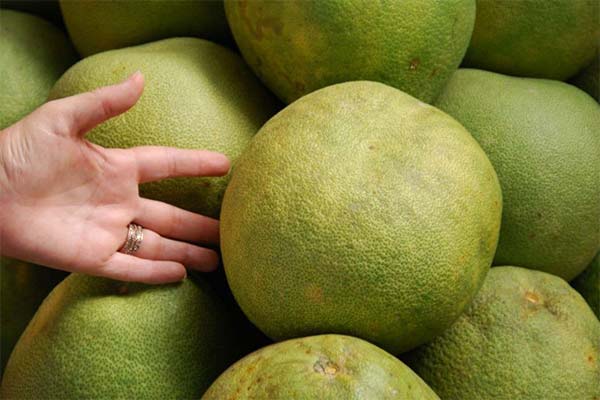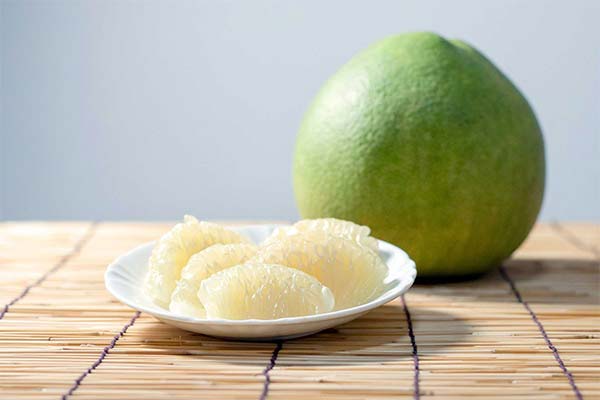How to eat and peel the pomelo fruit correctly
- What is a pomelo and where does it grow
- Types of
- How does a pomelo differ from a grapefruit?
- How to buy a ripe pomelo in a store
- How to peel a pomelo quickly
- The vertical method
- The spiral method
- How to eat a pomelo fruit?
- How much can you eat per day?
- Can I Eat a Pomelo Fruit at Night?
- Why is a pomelo bitter?
- Why is a pomelo good for you?
The fruit of the pomelo is characterized by its large size. It's hard not to notice this citrus on the counter. Pomelo as a healthy and tasty dessert will decorate both everyday and festive table.
What is a pomelo and where does it grow?
The pomelo is a fruiting evergreen tree that biologists classify as a separate species. This plant belongs to the large genus Citrus of the vast Root family. The fruit is called by the same name as the fruit tree itself. The plant is also called pompelmus or shaddock. In some sources, this citrus is referred to by the word "pamela."

The trees flower and bear fruit 2-4 times a year, which does not affect the weight or quality of the fruit. The harvest lasts all tropical winter, from December to March.
The tree's sturdy and flexible branches are covered with white flowers of a complex structure. The middle part of the flower is elongated and ends in a large greenish pistil, which is surrounded by bright yellow stamens. The small outer petals are curved outward.
In some citrus cultivars, the flowers form lush clusters of inflorescences. After flowering and fertilization, 1-2 fruits are set in the bunch, and the remaining flowers fall off. Other varieties of pomelo bloom in single or paired flowers. The flowers are 3-7 cm in diameter.
The sturdy branches of the fruit trees are covered with stiff green leaves. The leaf plates of the pomelo resemble those of the laurel, but are several times larger than they are.
The tree has a spherical crown and can grow to a height of 10-15 m. Most varieties of pomelo, however, are stunted. The largest fruits weigh 7-10 kg and have a diameter of 30 cm.
The fruits of the pomelo are round, less often pear-shaped. The fruits of all varieties have a characteristic structure. Inside the citrus fruit are isolated lobules separated by septa. The lobes do not always contain seeds. The taste of the fruit is sweet, sour-sweet with a bitterness. The fibers and tissues of the sepals are stiffer and drier than those of other citrus fruits.
The fruit is covered with a thick rind, and the juicy slices are protected by a thick shell of spongy, porous tissue. This layer is called the mesocarpium, or albedo. The thickness of the mesocarpium can reach 4-5 cm or more.
The color of the peel and slices depends on the cultivar. Pomelos are grown with yellow, orange and green peels, with red, cream and yellow slices.
Interestingly, only cultivated, domesticated varieties of pomelo are currently known. The wild ancestor of this citrus is not found either in the tropics or elsewhere on the planet. Biologists have figured out that the pomelo is a hybrid that came about by accidental crossbreeding of citrus plant flowers. One of the crossbreeders may have been a Pomeranian. It happened a long time ago, thousands of years ago. For example, the pomelo is mentioned in Chinese writings dating back to about 100 B.C.
Where does the pomelo grow? The citrus fruit is grown in regions with tropical and subtropical climates. Pomelo is cultivated in gardens and agricultural plantations in Thailand and China, Taiwan and Malaysia, India and Vietnam, Sri Lanka, in the south of Japan. Citrus orchards that grow pomelos are found in Morocco, South Africa, and the United States (California). The pomelo bears excellent fruit on the islands of Polynesia and in Turkey.
Species
The genus Citrus includes one species of pomelo plant. All known varieties of this fruit tree belong to this species.
According to specialized sources, there are at least 20 varieties of the pomelo tree. The most common and popular are:
- Khao phuang (Khao phuang). Produces pear-shaped citrus fruit with a dense, fleshy yellowish-green rind. The yellowish-white or cream-colored slices are filled with sour-sweet juice.
- Khao paen. Considered to be a Thai variety. Fruits are flattened spheres with thick, dense greenish-yellow or lettuce colored rinds. The edible lobes are creamy yellow, pale orange, and juicy. The fruit for sale has undeveloped seeds which ripen during storage.
- Khao namphung. Produces an unusual pear-like fruit with a bright yellow, greenish-yellow rind. The slices are large, sweet and juicy. The color of the flesh is pastel white or yellowish.
- Thongdi (Fongdi or Thongdi). Grows very well in Thailand. The peel of this citrus is finer than that of most Asian varieties of the species. The color of the peel is dark green and the surface of the fruit is smooth. The fruits are large (up to 15-17 cm across). The slices are a soft pink or watermelon red. The taste is sweet.
- Khao horn. Fruit with yellowish-green skin. The slices of this citrus are large and relief colored in light yellow tones.
How the pomelo differs from the grapefruit
These citrus fruits differ in size, appearance, and taste, although some varieties of these species are very similar.
Grapefruit is a hybrid of C.Sinensis orange and Shaddock pomelo. Biologists consider the re-pollination of these plants to be accidental. But the result was stable, and the new fruit got its own name. This happened in 1750. Since crossing was not originally intended, the Welsh naturalist monk G. Hughes called the grapefruit "forbidden fruit".
Citrus fruits have several differences.
- The taste of grapefruit always has the sourness characteristic of an orange. There is always a bitterness in the fruit.
- Pomelo can taste sweet or sour, with or without bitterness.
- The mesocarp of a pomelo is several times thicker than the mesocarp of a grapefruit.
- Pomelo slices have much tougher fibers and films than grapefruit.
- The grapefruit rind is colored orange. Pomelos can be thick green, lettuce gray, yellowish, or grayish orange.
- The color of the fruit slices also differs. Grapefruit has dark red, bright red, burgundy, and pinkish red flesh. The pomelo is creamy yellow, white, pale yellow, and only a few varieties are red.
How to choose a ripe pomelo in a store
This citrus fruit is selected using the general rules of fruit buying. Examine the pomelo carefully and assess its quality. You can buy the fruit if it is:

- The peel is smooth, firm, and free of dark spots, depressions, and traces of strong compression.
- There is a fresh, fruity aroma coming from the fruit, but not a rotten smell.
- The fruit is evenly colored.
- The stalk area remains firm under pressure, and the finger does not sink in.
- The peel shows no signs of desiccation, and the citrus does not seem too light.
- The fruit is firm and hard, overripe fruit is always soft and may be bitter.
When buying fruit pay attention to the negative qualities of the product:
- Strong irregularity in the color of the rind indicates that farmers have used too many chemicals and mineral fertilizers.
- You should not buy a fruit with scars from mechanical trauma visible on its surface.
- The excessive use of nitrates is indicated by burgundy spots on the skin, as well as spots that contrast with the overall color of the fruit.
You should not buy fruit with a sticky surface, it's an indication that the product has been stored mixed with rotten specimens. Microorganisms could penetrate into the healthy fruit and reduce its quality.
How to peel a pomelo quickly
If you do not peel the pomelo, but simply cut it into four to six pieces, you will lose a lot of juice. There are several simple ways to peel the fruit. You will need a sharp, medium-sized kitchen knife for the job. Connoisseurs in the kitchen distinguish between vertical and spiral methods of peeling. Before removing the skin, the fruit is washed with cool running water or in any spacious container, changing the water 2 times.
The vertical method
Place the pomelo on a cutting board or on a table, plate or tray. The main thing is that the fruit should not slip. Use a knife to cut off the stalk area and the opposite part of the peel, along with the spongy layer. Make four longitudinal cuts through the skin and the mesocarp layer. First make a circular incision that runs like a meridian on a globe. Then another one, perpendicular to the first one, then 2 more in the same pattern.
Put the knife aside, take a pomelo, remove the segments of peel and spongy pulp with your hands until there are no edible slices of fruit left in your hands. Then hands separate the slices and remove the membranes.
The spiral method
Spiral peeling is slightly different from the previous method. Cut off 1 cm area of the stalk, as well as the opposite part of it. Then the peel and mesocarp are removed by moving the knife in a spiral. Cleaning begins as in the previous method, from the upper preparatory cut to the lower one. Then separate the slices and peel them from the membranes.
How to eat pomelo fruit
It is better to eat the citrus fruit fresh, immediately after cleaning. Serve whole slices, cleaned of white veins and membranes. You can cut the slices or split them up with your hands.

- The fruit is delicious with ice cream, yogurt, fresh and canned cream.
- The pomelo flavor pairs well with kiwi, bananas, apples, celery and chocolate.
- The fruit enhances unsweetened salads with shrimp and olives.
- There are quite a few recipes where pieces of pomelo are combined with meat and fish. You can safely add pomelo to any salad.
- The juice of the giant citrus is used to make homemade marmalade and jelly.
For your information. The doctor may allow a diabetic patient to eat pomelo, as the glycemic index of the product - no more than 30 units.
How much you can eat a day
The amount of pomelo per day is not marked by any serious recommendation. This fruit has only recently appeared in stores. When including the product in the menu, you should be guided by the general intake norms developed for citrus fruits. The amount of product on the table depends on individual health indicators and age, acidity of gastric juice, tendency to heartburn, allergic reactions to the fruit, childhood age, diseases and pregnancy.
A healthy adult can eat 1 pomelo a day if the volume of peeled slices does not exceed the size of an average orange. Children under one year of age should not eat citrus fruits and juices. The child's digestive system is imperfect, the baby will suffer from pain, gas and discomfort. The child begins to give the citrus fruit juice in drops, adding it to drinking water. But it is better to consult a pediatrician. A child can be extremely susceptible to citrus fruit until the age of 3.
Children from 3 to 6 years of age can include pomelo in their diet, but not more than 3 times a week (give a few slices equal in volume to 2-3 small tangerines).
Can I eat pomelos at night?
Adult healthy person can eat pomelo at night, but it is better to do it before 15-16 hours. Vitamins and other beneficial substances contained in citrus fruits are better absorbed in the morning and at lunchtime. If the product is well absorbed, you can eat a couple of slices in the evening, but no later than 2 hours before going to bed.
But getting up at night and eating pomelo is not allowed. In the prone position there is an increased risk of throwing acid from the stomach into the esophagus, which leads to severe heartburn.
It is better to eat citrus fruits between breakfast and lunch, after dinner, since these products often cause intestinal discomfort. It is not recommended to combine pomelo with sparkling mineral water. The juice of this fruit should not be washed down with medicine.
Why is a pomelo bitter?
Bitterness is in the flesh of all citrus fruits, and the pomelo is no exception. The bitterness can be subtle. You can buy a fruit that is completely devoid of an unpleasant aftertaste. But sometimes a pomelo is quite bitter.
- The bitterness is caused by the glycoside naringin (naringenin neohesperidoside). The glycoside is present in the membranes and veins that cover the slices of the pomelo. If you remove the membranes and veins, the bitterness disappears.
- Ripe fruit are very bitter and unripe fruit are less bitter. Fruits of optimum ripeness almost no bitterness.
- Bitterness accumulates in the fruit if the fruit and foliage have been heavily sprayed with insect pesticides.
- If the pomelo has been frozen (or severely cooled to near freezing temperatures), it will also develop bitterness.
How is the pomelo good for you?
The fruit is high in vitamin C, with 30-55 mg per 100 grams. The pomelo fruit is rich in vitamins B1 (up to 0.07 mg per 100 g) and B2 (0.02 mg per 100 g of pulp). The slices have a high concentration of vitamin B5, beta-carotene and ethacrynic acid, which is a natural diuretic.

The edible part of the citrus has a lot of vegetable fiber (0.8%). Fiber is important for timely colon cleansing and prevention of constipation.
There are many useful trace elements in this fruit. In the pulp there is a large amount of potassium (up to 230-235 mg per 100 g). This macronutrient is important for normal heart function, useful for the prevention of arrhythmias.
Pomelo contains quite a lot of iron (0.11 mg), phosphorus (17 mg), sodium (up to 1 mg), calcium (4 mg) and other important macronutrients. The product has very little natural fat (0.1 to 0.3%). The caloric value of the fruit is low. In 100 grams of citrus contains 25-38 kcal.
- It is good to include pomelo in the daily diet, as the fruit has not only a nutritious, but also a restorative and healing effect.
- The fruit contains antioxidants, which are important for many reactions.
- Red pomelo flesh contains cholesterol-lowering substances.
- Pomelo is a source of phosphorus and calcium. It is recommended to introduce it into the diet of elderly people suffering from osteoporosis and other diseases of the bone apparatus.
- Phosphorus is useful for full brain function.
- The high content of calcium makes this product useful for pregnant women, as this element is needed not only for the child, but also for the future mother. The peculiarities of introducing pomelo into the diet should be discussed with your doctor.
- Due to its high vitamin content, the fruit strengthens the human immune system.
- Diuretic properties of the product activate the metabolism, the timely removal of toxins and waste products. It is worth eating people who suffer from high blood pressure.
- The product is useful for women during menopause. Citrus contains substances that stabilize estrogen levels and normalize hormone levels.
- The fruit is believed to alleviate asthma and bronchitis.
- This low-calorie product is included in diets for weight loss.
- Pomelo is considered an aphrodisiac that activates the sex drive in men.
Pomelo is removed from the diet if an allergic reaction to the fruit is detected. Citrus can not be eaten with gastritis, stomach ulcers, colitis, duodenal ulcers, certain kidney diseases.
Pomelo is directly related to religious cults in Southeast Asia. This fruit is often used as an offering to the spirits, including during the celebration of the Eastern New Year. These large, beautiful and tasty fruits symbolize well-being, happy life and prosperity.
«Important: All information on this site is provided for informational purposes only. for informational purposes only. Before applying any recommendations, consult a health care professional. specialist. Neither the editors nor the authors shall be liable for any possible harm caused by materials."















